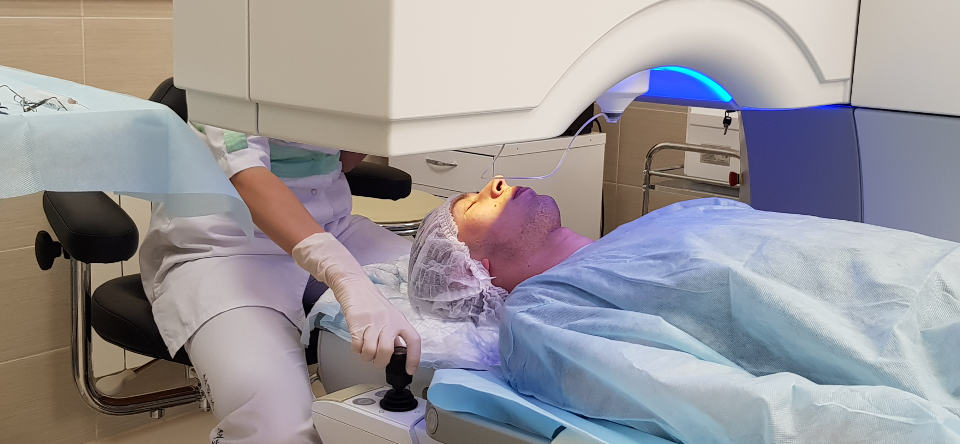Phototherapy (PTK) and photorefractive (PRK) keratectomy for keratoconus treatment
In recent years, for the treatment of the initial stages of keratoconus began the use of excimer laser effects on the cornea, strengthening its Bowman shell. This treatment procedure is called phototherapy keratectomy (PTK), although it should be noted that the essence of this procedure is slightly different from the photorefractive keratectomy (PRK), which is carried out with myopia.
Studies of many scientists have shown that the pathological process in keratoconus develops in the direction of "front-back" - that is, it begins in the anterior layers of the cornea and, gradually progressing, moves into the thickness of the cornea, leading to degeneration,thinning, protruding cornea. Given this feature of the pathogenesis of keratoconus, we proposed to stop the process at the beginning, affecting the anterior layers of the cornea.
This method can be applied only on first stage of keratoconus, when just external layers of cornea is engaged.
Method
Before the operation is carried out, the cornea is examined using computer topography and the apex of the cone is determined. To prepare for a photorefractive keratectomy, the operated eye is buried with an anesthetic drug, the second eye is closed with a bandage.
The operation of the excimer laser beam is controlled by a computer program, according to which the ablation of the cornea is made by 15% more than is recommended to achieve emmetropy and eliminate astigmatism. The laser beam is centered on the top of the cone, and then excimer laser photorefraction keratectomy with an ablation zone of 4.8-5.0 mm is performed.
PRK is carried out with an ablation zone equal to 5.8–7.0 mm with under–correction of vision by the spherical component to the value (-1.0)–(-1.5) D and by the cylindrical component to the value (-0.5) - (-1.0) D, after which phototherapy keratectomy is performed.
This method can make to stop the progression of keratoconus (combined with cross-linking) and improve visual acuity. The procedure is performed on an outpatient basis, antibiotics, eye drops or ointments are constantly used in the rehabilitation period. The patient within six months, it is necessary to have on hand a substitute for lacrimal fluid.
Complications
- Delay in re-epithelialization
- Turbidity of the cornea
- Irregular astigmatism
- Recurrence of the dystrophy or herpetic keratitis
- Infectious keratitis
Prognosis
Depending on the indications for the PRK, the prognosis can vary from favorable to satisfactory. In General, the less deeply located pathological changes in the cornea, the better result can be achieved after photorefractive keratectomy.

Other indications for use of PRK
Excimer laser operations can be therapeutic, optical-reconstructive, cosmetic and combined.
If excimer laser surgery is therapeutic, it is performed in order to accelerate the healing of epithelial or stromal ulceration, as well as to eliminate the corneal syndrome, achieved by removing the epithelium and tissues of the corneal stroma, which have undergone pathological changes in the case of inflammation of the eye.
If the surgery for corneal pathology is optoico-reconstructive, then optical and reconstructive interventions are carried out simultaneously, for example, removal of mixed subepithelial opacities from the surface layers of the corneal stroma, which is carried out after preliminary refractive manipulations.
Excimer laser cosmetic keratectomy is advisable to improve the appearance of the anterior segment of the eye in the case of corneal cataract in the eyes with low residual vision or blind eyes.
Combined excimer laser operations are called different variations of the combination of optical-reconstructive, therapeutic and cosmetic manipulations, which are aimed at removing the corneal syndrome while achieving optical, refractive, optical-refractive or cosmetic effect.
The main difference of excimer laser combined operations in corneal pathologies is that microsurgical manipulations are also used to achieve the final therapeutic or optical-reconstructive effect during the procedure along with the excimer laser.
In the foreign literature concerning excimer laser operations in corneal pathologies, two main terms are used: phototherapeutic keratectomy (PTK) and photorefractive keratectomy (PRK).
Phototherapeutic keratectomy is widely used for therapy for different diagnoses of the pathologies of the cornea: degeneration and dystrophy, recurrent erosion, irregularity of the cornea, postoperative and post-traumatic scars, keratoconus and blurry, caused by the keratitis of various etiology.
The best result of usage of excimer laser PTK is achieved with surface opacities of the cornea – no more than 1/3 of its thickness. However, there is a group of ophthalmologists who consider justified keratectomy using an excimer laser in the case of uneven depth of opacities, in some areas reaching 1/2 the thickness of the corneal stroma.
Excimer laser keratectomy (full or partial) usually is used for ulcerative pathologies of the cornea of viral or bacterial etiology, which are not amenable to conservative treatment. For Keratocons treatment, when there is scars on the cornea, is possible to perform optical-reconstructive keratectomy using an excimer laser in the case of corneal opacities that extend to 1/4–1/2 stroma at an initial thickness of at least 430 µm in the Central optical zone, regardless of the cause of the process that caused the opacity.
Price of phototherapy and photorefractive keratectomy
The cost of FTC or PRK in our ophthalmological center is 80 000 rubles per eye (1150$).




If you mentioned IV stage of KC, I think the single way to cure it - is penetrating keratoplasty (or microinvasive lamellar keratoplasty, which we provide in our ophtalmic center) because other methods will be not effective.